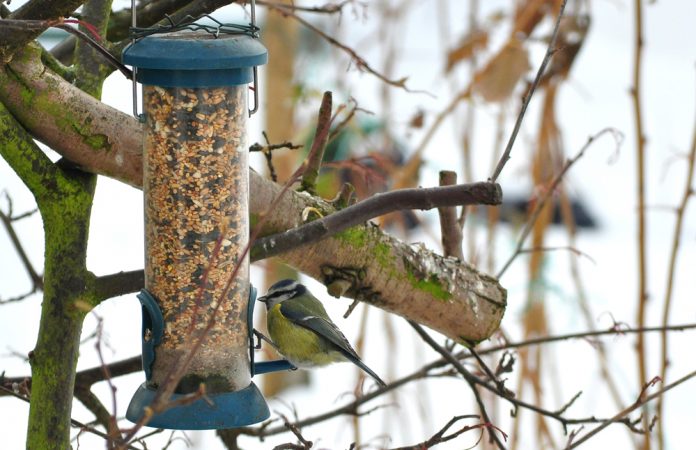When readers ask for help selecting a bird feeder, I’m happy to oblige.
I bought my first feeder in 1978 in Michigan, so I’ve had lots of experience evaluating them. I won’t presume to identify the “best” feeders, but I can name my favorites in both general and specific terms.
No wood
My first bit of advice is to avoid feeders made of wood. Though wood feeders are popular and aesthetically pleasing, wood acts like a sponge.
It absorbs the oils found in virtually all seed products. It takes time, but eventually, the oils impregnate the wood.
The associated odor is a magnet for squirrels, chipmunks, raccoons and bears.
Rather than have critters literally eat my feeders, I gave up on wood products years ago.
Today I use feeders made of polycarbonate plastics, metal, and recycled plastic “wood” exclusively.
That first feeder I bought in 1978, by the way, was a small Droll Yankees tube, and it served me well for more than 30 years.
Manufacturers
If you are just beginning to feed birds, I suggest tube feeders made by Droll Yankees (www.drollyankees.com) or Aspects (www.aspectsinc.com).
I prefer these manufacturers because they’ve been in business for decades, they make their feeders in the U.S., and they stand behind their products.
These feeders can also be purchased at nature centers, garden centers, and wild bird specialty stores.
If you are so inclined, take this column to a retail store and ask for a small discount. Store managers appreciate knowing what brings people into the shop.
The “All-Weather Feeder” by GoldCrest is an oversized tube that is truly weatherproof and perfect for dispensing sunflower kernels. Kernels are expensive and spoil quickly when wet, so it’s important to keep them dry.
I consider stainless steel wire mesh nut feeders to be modified tubes, and I highly recommend them.
Filled with shelled nuts, nut feeders attract an endless parade of woodpeckers, chickadees, titmice and nuthatches.
Fine wire mesh tubes are ideal for Nyjer® seed and perfect for finches.
Platform and hopper feeders are usually made from wood. I use these types of feeders, but only those made from recycled plastic “wood.” This material costs more than real wood, but it’s easy to clean and lasts almost forever, so it’s a good value.
If you choose to go with platform and/or hopper feeders, remember that they are nonexclusive — all birds can use them.
Unfortunately, these feeders can be dominated by pigeons, crows, doves, blue jays and squirrels.
Bowl feeders hang beneath a squirrel baffle and lack perches. That’s why only smaller, acrobatic birds with strong clinging feet can use them.
Fill bowls with shelled nuts or sunflower kernels to attract woodpeckers, chickadees, titmice, and nuthatches.
For years my favorite bowl style feeder has been Droll Yankees’ “Big Top.” It fills quickly and easily even in cold weather, it holds a lot of seed, and it excludes larger birds such as pigeons, doves and grackles.
Fill it with sunflower seeds, kernels, and shelled nuts.
Window feeders that attach directly to a window pane are great for kids and anyone who is housebound. They can bring birds within just a few feet of the dining room table or a bedroom window.
Stainless steel suet baskets are inexpensive and durable, and no backyard should be without at least one.
Chickadees, titmice, nuthatches and woodpeckers are among backyard suet lovers.
Another of my favorite feeders is Droll Yankees’ “Covered Platform Feeder.” It consists of a 1-inch deep, 13-inch circular polycarbonate tray covered by a movable dome.
The dome can be lowered to exclude bigger birds, and it protects the food from rain and snow. The tray can be filled with seed, nuts, mealworms, fruit or even suet.
And I’ve found that when I fill the tray with sunflower seeds, birds rarely empty it by the end of the day.
The best thing about the Covered Platform Feeder is that there’s no place to hide.
On many feeders, birds get shy and use the far side of the feeder to stay out of sight. The metal post that connects the tray to the dome is only 3/16-inch in diameter, so I can always see all the birds on this feeder.














I like how you mentioned that all birds can use either platform or hopper feeders which make them noninclusive. My wife is thinking of looking for outdoor bird feeders online because she’s considering putting one in her garden to feed the feathered creatures that roam around the plants and trees. I think it’s a good idea for my wife to consider all of her options when buying a feeder from a reputable store to help provide food for the fowl in our yard.
Scott, it’s great that you warned from buying bird feeders made out of wood because they’re a magnet for pests and other animals. I’m planning to buy a wasp-proof hummingbird feeder online within the week because I found out that we have some birds nesting on our oak tree. I’ll keep what you said in mind and look for polycarbonate plastics or metal feeders. Thanks a lot!